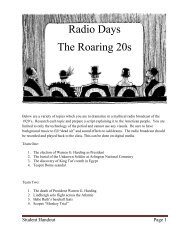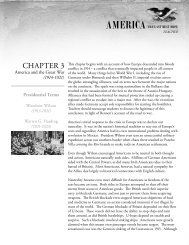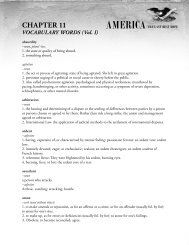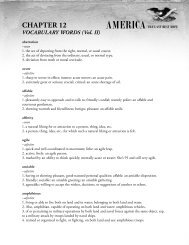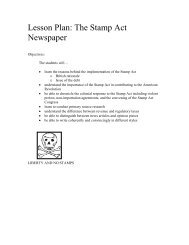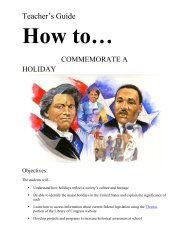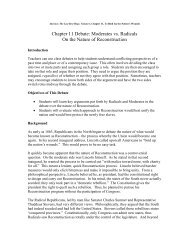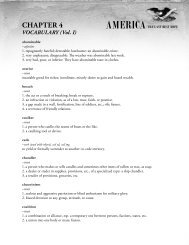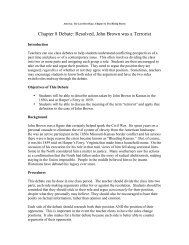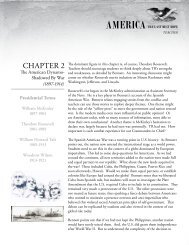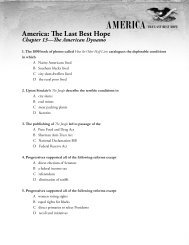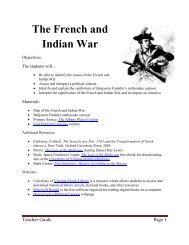Chapter 2 Student Summary - Last Best Hope
Chapter 2 Student Summary - Last Best Hope
Chapter 2 Student Summary - Last Best Hope
You also want an ePaper? Increase the reach of your titles
YUMPU automatically turns print PDFs into web optimized ePapers that Google loves.
AMERICA: THE LAST BEST HOPESTUDENTCHAPTER 2The Boom and the Bust(1921-1933)Presidential TermsWarren G. Harding(1921-1923)Calvin Coolidge(1923-1929Herbert Hoover(1929-1933)The opening section of the chapter offers a glimpse of why the decade of the1920s is remembered as “roaring.” After experiencing the horrors of combatin World War I, younger Americans turned away from Wilsonian idealismand instead turned inward and focused on the new consumer revolutionmade possible by the widespread availability of new technology (automobiles,radios, appliances) and spurred by new forms of mass communication.Women could not only vote now, but changing manners and morals gavethem the opportunity to take a more active role in society. Bennett calls thisthe “new freedom.”The chapter continues with a brief interlude telling the story of FranklinRoosevelt’s struggle with polio. It is truly one of the remarkable examplesof perseverance in our nation’s history. In our modern age, we can scarcelyunderstand how terrifying polio was to earlier generations of Americans.Eradicating the disease from the globe is one of history’s greatest publichealth victories. In overcoming this challenge, the support of EleanorRoosevelt was critical. FDR’s return to politics was both courageous andunheard of. FDR went to great lengths to downplay the fact he could notwalk to the general public.The 1920s was also a pivotal decade for African-Americans. Marcus Garveywas controversial, but his message of “Black Pride” was crucial for a peoplestill facing the reality of Jim Crow in much of the nation. The HarlemRenaissance was a turning point in African-American history. It particularlyimpacted African-Americans who had come north in the early twentiethcentury. This “Great Migration” (the greatest movement of people in ournation’s history) of blacks from the former slave states to northern citieswas accelerated by the industrial jobs made available in the North by thewar. In the North, African-Americans added greatly to American culture inthe areas of music and literature – all part of the “Renaissance.” There wascertainly more freedom there, but blacks still lived in a very divided world.Politically, the Republican Party dominated Washington D.C. in the 1920s.President Warren Harding is generally regarded as one of our weaker, leasteffective presidents. Bennett relates the numerous scandals that plaguedhis administration. He clearly could not control his “Ohio Gang.” Greatpresidents normally surround themselves with excellent leaders. This wasnot the case with Harding. His tenure did see a major international pact,
AMERICA: THE LAST BEST HOPESTUDENTthe Washington Naval Treaty. In reaction to the naval arms race that helpedlead to World War I, the world’s leading powers elected to limit the size oftheir navies, based on a formula.Upon Harding’s death in office, Calvin Coolidge became president andhis strong integrity restored respect for the Oval Office. “Silent Cal”presided over the nation as it faced significant social and cultural challenges.Prohibition was the law of the land, but was openly disregarded byAmericans from all classes and walks of life, diminishing respect for the law(It is a common misperception that alcohol consumption went up duringProhibition, it actually went down considerably). Another challenge wasimmigration from other countries. The period from the late 19th centuryto the 1920s was one of the great eras of immigration in our history. ButAmericans became alarmed that the “new immigrants” – largely fromsouth and east Europe – were not assimilating and thus passed restrictiveimmigration laws that clearly discriminated against certain national groups.The eugenics movement reflected this belief in the superiority of certainnationalities. Even America’s greatest industrialist, Henry Ford, had deepprejudices against certain groups – particularly Jews. Distrust of these newimmigrants was also seen later in the decade in the reaction to Sacco andVanzetti, Italian anarchists tried and executed for murder.A major theme of the 1920s was the clash between tradition and modernism.It was seen in the defense Clarence Darrow mounted for Leopold and Loebin their sensational murder trial. It was seen in the battles at the 1924Democratic national convention between “wets” and “drys,” and on thequestion of whether or not to pass a resolution against the Ku Klux Klan.But most dramatically, this clash was seen in the trial of biology teacherJohn T. Scopes in Dayton, Tennessee. Although Scopes was convicted ofillegally teaching evolution, the forces of tradition seemed to be in retreat.Bennett gives a detailed account of Charles Lindbergh’s (The Lone Eagle)dramatic flight across the Atlantic. The 1920s was an age of national heroes– Babe Ruth, Bobby Jones, Red Grange, Jack Dempsey, Gertrude Ederle,and Rudolph Valentino. But none received the adulation given Lindbergh.This phenomenon was indicative of the new “mass culture” made possibleby dramatic new means of communication (radio, movies, mass circulationmagazines).As America focused inward (and some would say became isolationist), worldproblems began to emerge. Hitler was forming a movement in Germany,Mussolini took power in Italy, and Stalin killed millions in the SovietUnion. Americans remained unconcerned. The nation’s one major foray
AMERICA: THE LAST BEST HOPESTUDENTonto the world stage was its leadership in the adoption of the Kellogg-BriandPact, a treaty that made war illegal.The third Republican president of the decade was Herbert Hoover. Hedefeated Al Smith in the 1928 election. Smith was the first Catholic tohead a major party ticket. Hoover expressed the optimism Americans werefeeling that prosperity and the profits to be made playing the rising stockmarket would be endless. This ignored problems in the agricultural andmining sectors of the economy, indicators that there were indeed hard timeson the horizon. A major crash of the market came in October of 1929,setting off the Great Depression, an economic crisis that would last untilthe economy was revived by the buildup before and during World WarII. Unemployment rose to as high as 24%. Environmental disaster in theform of the Dust Bowl added to economic disaster in the Midwest, forcingthousand of families to leave everything behind and move to California,hoping to find work as agricultural laborers there. Things were so desperatethat some Americans gave up on capitalism and turned to communism.Americans to this day associate the name of Hoover with depression,poverty, and misery. Some of his actions certainly made things worse.Signing the Smoot-Hawley Tariff hurt workers even more by cutting offtrade. His strong suppression of the Bonus Marchers hurt his image severely.And most of all, once the crisis came, he simply did not inspire confidence oroptimism among the American people.There was virtually no way for the Democrats to lose in 1932, and indeedthey rode Franklin D. Roosevelt’s coattails to a landslide victory, takingthe White House and both houses of Congress. FDR promised a “NewDeal” for the American people, never quite making clear what that NewDeal would be. Ironically, during the campaign, FDR criticized Hoover forcentralizing the government and overspending. FDR would soon implementa growth in the size of the federal government like the nation had never seen.When FDR took office, he surrounded himself with his “Brain Trust,”academics and policy makers who were willing to try nearly anythingto get America back on its feet. FDR was quite willing to embrace boldexperiments. When some failed, he moved on to other attempts. ButFDR’s greatest asset was his ability to inspire. He wisely saw that fear wascrippling the nation and he challenged Americans not to fear, but ratherto believe things would be better. As he began the implementation of hisNew Deal, similar economic conditions around the globe (This was a worldwidedepression) caused democracies to crumble as desperate people turnedto totalitarian leaders who promised solutions. FDR knew that dramaticactions were necessary to save democracy and capitalism here.



